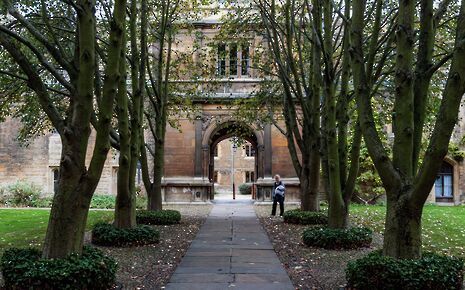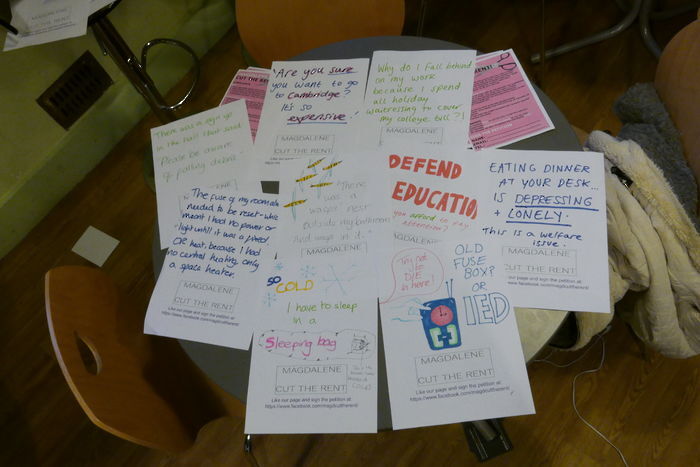Boost for ‘squeezed middle’ as Cambridge contemplates bursary expansion
A new University-wide financial support scheme will be aimed at students from poor backgrounds and those who aren’t eligible for current grants

Cambridge colleges are developing an expanded bursary scheme which will aim to raise provisions for the poorest students, while also expanding financial support to those in the “squeezed middle”.
The Senior Tutors’ Committee (STC), one of Cambridge’s top governing bodies, has convened a Colleges Bursaries Taskforce, which is in the early stages of planning an “enhanced bursary scheme in which all colleges could participate”, to replace uncoordinated measures already in place.
Dr Mark Wormald, secretary of the STC, said there was “clearly an appetite” for change to the current system, according to recently-released committee minutes.
Presently, many colleges offer bursaries to support students with their living costs. The new scheme will aim to take the disparate variety of bursary models across the colleges and integrate them into the main Cambridge Bursary Scheme, which provides standardised funding for students to cover maintenance costs such as rent and food. It could mean expanded financial support for students at colleges which do not have their own bursary schemes.
At the Taskforce’s launch in November, the colleges said its “work should be undertaken urgently to ensure that a scheme could be in place for the next academic year”. Wormald declined a request to comment made through the University.
The Bursary Scheme currently provides a “gift” of up to £3,500 per year for undergraduate students with a household income of below £42,620. Eligible undergraduates receive the grant automatically, regardless of whether they already receive a government loan.
The planned new bursary model will measure students’ household income alongside other methods of means testing, with students automatically receiving money based on a “sliding scale” of need. The University is undertaking a “parallel strand” of work, with the probable aim of unifying all the bursary schemes under one umbrella.
Changes could mean a boost for some students – the “squeezed middle” referred to – who qualify for lower levels of government maintenance loan, but may receive little or no funding from their families and are not eligible for a grant from Cambridge.
Got a story for us?
Seen something you think Varsity should be talking about? Contact our News team at news@varsity.co.uk.
The University’s analysis found that that average cost of living in Cambridge was between £8,300 and £8,800. This means that under the current system students with a household income of over £35,000 – but no exceptional dependencies or disabilities – must find other ways to cover their living costs. This can present problems as maintenance loans and Cambridge bursaries are not means-tested; for example, they fail to take into account the different financial pressures between families with the same household income but varied numbers of children.
The STC formed the Taskforce late last year, asking it to investigate current provision and develop a new system. Professor Catherine Barnard, senior tutor of Trinity College, said at a November meeting that a sliding-scale scheme developed by Trinity could be the basis of the new model. In the same discussion, CUSU President Daisy Eyre highlighted the importance of tackling rent disparities between colleges.
Both Eyre and Olivia Hylton-Pennant, CUSU’s access officer, are away and could not be reached for comment.
At a February meeting of the STC, Wormald reported on the Taskforce’s progress. Wormald was minuted as telling senior tutors: “That whilst it was very important to try to do something for students, it was key that it was the right thing”.
How can Cambridge tackle its access gap?
Write for Varsity and have your say. Just email our Opinion team with a 100-word pitch.
He said “real danger lay ahead if colleges did nothing and that there was only a finite window of opportunity to work with the University to develop a comprehensive collegiate support scheme.”
Wormald said that “whilst the existing Cambridge Bursary Scheme was transparent and fair, there was a need for it to be updated as the eligibility cut off had originally been aligned with governmental maintenance grants that had since been abolished.”
The Taskforce reported a mixture of early opinions from college officials. Staff said that effective means testing must not mean large administrative burdens.
In an extended discussion of the Taskforce’s plans, it was emphasised that any new scheme should “respond flexibly to genuine cases of student need” and “not lose sight of the very poorest students, particularly those with financial obligations in supporting their families”.
It was also stressed that while financial support was “absolutely key” to student experience, it “was not the only factor in relation to access, participation, performance and progression”. The minutes of the discussion note the STC as saying: “culture also played a significant part and that efforts to ensure levels of financial support were in place ought to go hand in hand with efforts to address perceived cultural imbalances”.
Campaign group Cambridge Cut The Rent welcomed the planned changes, but warned that it should not mean colleges raise accommodation costs. The new scheme “cannot be an excuse for colleges to simply raise rents,” a campaign spokesperson said, “otherwise this funding will go straight back into their pockets.”
Analysis published on Wednesday found that Cambridge was the “most unequal” university in the UK, and new figures released last week showed that the University’s 2016 intake had the second-lowest proportion of students from areas with lower participation in higher education.
Cambridge has made distinct targets for improving intake of students from disadvantaged backgrounds part of its official access agreements for several years. Administrators will hope that the new bursary scheme will help them reach those goals.
Tackling inequality
 News / Cambridge academics stand out in King’s 2026 Honours List2 January 2026
News / Cambridge academics stand out in King’s 2026 Honours List2 January 2026 Comment / Plastic pubs: the problem with Cambridge alehouses 5 January 2026
Comment / Plastic pubs: the problem with Cambridge alehouses 5 January 2026 News / Cambridge businesses concerned infrastructure delays will hurt growth5 January 2026
News / Cambridge businesses concerned infrastructure delays will hurt growth5 January 2026 News / AstraZeneca sues for £32 million over faulty construction at Cambridge Campus31 December 2025
News / AstraZeneca sues for £32 million over faulty construction at Cambridge Campus31 December 2025 Interviews / You don’t need to peak at Cambridge, says Robin Harding31 December 2025
Interviews / You don’t need to peak at Cambridge, says Robin Harding31 December 2025












